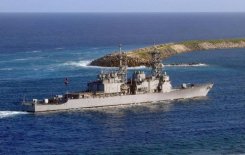 |
| Political leaders in Guan are seeking liberty from Washington © AFP/US Navy/File Alan D. Monyelle |
HAGATNA, Guam (AFP) – Almost 70 years after US Marines freed Guam from Japanese forces during World War II, political leaders on the Pacific island are again seeking liberty — this time from Washington.
The Marines who took Guam in a bloody 1944 battle reinstated the island as a “non-governing US territory”, meaning its 180,000 population enjoys US citizenship but cannot vote in US presidential elections.
Now, with plans to increase the US military presence in Guam by moving in 8,000 troops from Japan’s Okinawa, fears the native Chamorro population will be swamped by outsiders has given new impetus to calls for self-determination.
Governor Edward Calvo successfully campaigned on the issue in a January election and pursued it in his State of the Island address in March.
“I highly doubt the 1,744 Marines and soldiers who gave their lives in the Battle of Guam died so that the people they liberated could be colonised for eternity,” he said.
“Because we are still an unincorporated territory (of the US) we have not reached our full potential. We should be able to determine where we want to go to as a community.”
Guam, whose economy depends largely on US military spending and tourism, first came under US control when Spain ceded it to Washington in 1898 after the Spanish-American War.
It is one of only 16 places classified by the United Nations as non-self-governing territories, or colonies, remaining in the world.
Calvo has said he wants to hold a plebiscite on self-determination in 2012 but that need not mean cutting ties with Washington. Voters would be able to express their preference for one of three options — US statehood, independence or “free association” with Washington.
Free association, a status accorded to neighbouring Pacific states the Marshall Islands, Palau and Micronesia, would give Guam recognition as a sovereign nation but it would retain close ties with the United States.
University of Guam president Robert Underwood said the time was ripe to revive the quest for home rule after three attempts between 2000 and 2004 stumbled because of a bureaucratic hurdle over voter registration.
He said Guam’s local population needed to assert itself before the impending US military expansion, scheduled to take place in 2014.
“A society that is unfulfilled politically will always allow uncertainty to affect its development. It is important to resolve this issue now,” Underwood said.
He said that while the island was always likely to remain economically dependent on the United States, that did not mean it was politically unable to rule itself, adding: “Most people in the world today are interdependent.”
Guam’s population has become increasingly multi-ethnic since World War II, currently comprising about 40 percent indigenous Chamorro, 27 percent Filipino, 12 percent from other Pacific islands and the remainder Caucasian or others.
Local scholar and cultural activist Jonathan Diaz said the Chamorro, who first settled on the island about 4,000 years ago, deserved to determine how their native land was governed.
“I think the diversity and composition of Guam’s population may hamper the effort but, in actuality, if outsiders know and understand the story of the Chamorro people, they will let us vote,” he said.
© AFP — Published at Activist Post with license
linkwithin_text=’Related Articles:’
GS_googleAddAdSenseService(“ca-pub-1897954795849722”);GS_googleEnableAllServices();
GA_googleAddSlot(“ca-pub-1897954795849722”, “Enerfood_Bonus”);
GA_googleFetchAds();
GA_googleFillSlot(“Enerfood_Bonus”);

Be the first to comment on "Guam mulls going its own way"